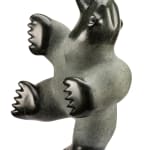-
Artworks
NALENIK TEMELA (1939-2003) KIMMIRUT (LAKE HARBOUR)
Dancing Bear, 1988stone, 27.5 x 16.5 x 16.5 in (69.8 x 41.9 x 41.9 cm)
signed, "ᓇᓕᓂ / ᑎᒥᓚ / 88".LOT 152
ESTIMATE: $20,000 — $30,000
PRICE REALIZED: $20,400.00Further images
Nalenik began carving in the mid 1950s at the age of fifteen, and likely created small ivories for the first few years. By the late 1960s he was carving larger...Nalenik began carving in the mid 1950s at the age of fifteen, and likely created small ivories for the first few years. By the late 1960s he was carving larger stone sculptures, mostly depictions of bears and other wildlife. Nalenik and his family moved into Kimmirut only in the late 1970s, preferring life on the land until that time. His attitude to carving was decidedly old school as well; he preferred using simple home-made carving tools. His dedication to his art is summed up nicely here: “I admire and like to watch other carvers working. They inspire me to work just as hard as they are, which helps me to keep doing my best, especially during long, hard, cold winters when I have to work outside” [1].
Nalenik is best known and celebrated for his monumental depictions of bears that he began carving in the late 1980s, three of which were exhibited in the international Masters of the Arctic exhibition of 1989. These works are truly distinctive for their textural effects. The bears’ matte, delicately textured torsos and limbs contrast strongly with their highly polished heads and paws; it’s a clever invention that makes Nalenik’s bears really stand out. Nalenik presented his bears in various poses, but it was his choice of the “dancing bear” pose that inevitably led to comparisons with the renowned Cape Dorset sculptor Pauta Saila.
This Dancing Bear is one of Nalenik’s finest. Like Pauta, Nalenik has an eye for balance and proportion. The bear is large and massively heavy, but visually the work is broken up into smaller rhythmic units because of the textural changes, and our eyes are also drawn around the work because of its lovely sinuous outline. One of Nalenik’s trademarks is the crisp, almost angular treatment of the bear’s fur that runs down the animal’s neck; the beautiful S-curve here is especially sexy. Nalenik’s treatment of smaller details such as the bear’s claws and its creased snout are also highly distinctive. Terrific.
1. From an artist interview with Rob Jaffray in Kyra Vladykov Fisher, Guide to Kimmirut Artists: 2005-2006 (Municipality of Kimmirut, 2005), p. 111.
References: For another fine Dancing Bear by the artist see First Arts Auction, July 2020, Lot 99. For three equally large but differently posed examples of bears by the artist see Amway Environmental Foundation, Masters of the Arctic: Art in the Service of the Earth (1990), cover and pp. 66-67. The international touring exhibition was inaugurated at the United Nations General Assembly Gallery in NYC. See also George Swinton, Sculpture of the Inuit, (Toronto: McClelland & Stewart, 1992), fig. 893. For an interesting Seated Bear by the artist from the early 1970s see Walker’s Auctions, May 2013, Lot 93.Provenance
Maslak McLeod Gallery, Toronto;
Private Collection, Toronto.
Join our mailing list
* denotes required fields
We will process the personal data you have supplied in accordance with our privacy policy (available on request). You can unsubscribe or change your preferences at any time by clicking the link in our emails.








